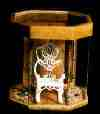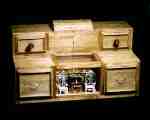Each chair is a marvel not only of craftsmanship--none are more than a couple inches high--but also of concentration, which may have to do with where they are made: in a cell at Menard Correctional Center, the maximum-security prison in down-state Chester.
Like many a prison-made art object, they reflect the virtue of necessity, not only in the amount of time Harms has available to devote to them (an average of 40 hours per tiny chair, he says), but in his materials and tools: He carves them from bars of soap using only a pair of sewing needles.
One chair has a butterfly for a back, another an American flag, another the branches of a budding plant Most common are geometric abstractions, in complex patterns that would be impressive on a full-size chair, let alone at this scale. Some chairs have ducks carved into them, others, have roses laid on the seat.
Life-like vines wrap around behind some of them.
"He has forms in all his work that I don't catch until he tells me in his letters," says Lynne Bailey, a dealer in inmate art who has loaned a number of pieces for a show at the Illinois Art Shop in the James R. Thompson Center. Sixteen of Harms chairs can be seen through May 26 in the show, along with work by six other prison-artists and striking photographs of prison life by Lloyd DeGrane.
It's a rare opportunity for these artists, a chance for public recognition different from the kind they more commonly receive, and a chance to break down a bit of the isolation so basic to their lives.
For art dealer Phyllis Kind, who has shown Harms' chairs at her New York gallery, that insularity can have its advantages.
"If you come across someone isolated from those pressures (of the academic art world ), we know they don't have influences, such as the art market or friends. They're doing it even though they assume that nobody likes it or nobody ever will.
"That's why the authenticity of this sort of work is not for a minute questioned. This had to happen, this work was necessary for him. It makes him alive," says Kind. "This person is making something because they can't not make it."
In Harms' case, that necessity extends to the  boxes in which he presents his chairs. They are almost as exquisite as the soap carvings and equally influenced by the prison environment. He makes them from Popsicle sticks using nail clippers, and he colors them with a stain extracted from rusty steel wool and tinted with colored pencil. The end results, finished with floor wax and varnish, belie their humble origins, looking more like fine veneers than prison-cell make-dos.
boxes in which he presents his chairs. They are almost as exquisite as the soap carvings and equally influenced by the prison environment. He makes them from Popsicle sticks using nail clippers, and he colors them with a stain extracted from rusty steel wool and tinted with colored pencil. The end results, finished with floor wax and varnish, belie their humble origins, looking more like fine veneers than prison-cell make-dos.
Harms equips each of his chairs, which retail for $100 to $400, with an index card that shows the number of pieces in the chair (usually around 30 to 60), the number of hours it took to make it, the pieces and hours that went into the display box and other information, including care instructions.
In one example, a chair finished May 6, 1994, contains 49 pieces and took 21 hours. The materials are Ivory soap (the "state soap" doesn't work for carving, he says), white glue, acrylic (two applications of acrylic give a protective coating) and varnish (to strengthen the pieces). The display case has 48 pieces and took 17 hours to build using Popsicle sticks, white glue and plastic. The rose that sits on the chair has 34 pieces and took three hours. It's made from an emulsion of colored pencil shavings, water and glue.
Another chair is surrounded by a garland of roses that contains "approx. 300 leaves, roses (42)." It took 120 hours to make and, all told, contains 1,146 pieces.
One work places a pair of chairs in a  full-size jewelry box (made from Popsicle sticks) along with an occasional table, a miniature fireplace and mantel, a duck and some plants.
full-size jewelry box (made from Popsicle sticks) along with an occasional table, a miniature fireplace and mantel, a duck and some plants.
Harms, who says the details in his work just come out of his head as he makes it, would carve more with wood if he could get the materials and tools. A reduction from his 50-year sentence (a resentencing hearing is pending) and a transfer to a lower-security facility would make that possible.
Harms had worked at a number of jobs before a fatal fight with his girlfriend led to a murder conviction and the long sentence. ("It was a senseless, spontaneous crime committed against a loved one, mainly contributed to (by) alcohol abuse. I continue to search for answers as to why and how it happened," he explains in an artist's statement.)
A job at a cabinet shop in Florida made a big difference in his carving, he says. "That got me on the metric (system), which is finer. That got my detail down quite a bit."
Harms says he taught himself how to carve, which was his main hobby before he went into prison, along with taxidermy and fishing. One day when he was carving a fishing lure, the wood "broke in half and I had two rockers to a rocking chair," he explains.
He started "cutting soap" in 1991, when he entered Joilet's Stateville prison. (He was only recently transferred to Menard.) Now carving is his only pastime. He makes one, sometimes two, chairs a week, almost always rockers.
His standards for those chairs are high, according to Bailey. "He's never satisfied with his work. He sees flaws in every piece."
"A lot of thems way crooked. I got that pretty well straightened out now," says Harms, 32, who was born in Peoria and raised in nearby Bartonville.
"Here's the thing with the soap, it curves. Every single piece wants to curve one way or another when it dries. That's the whole thing about it. None of it's ever the same. It dries different," says Harms, who notes that once he starts carving a piece of soap, he can't stop or it will dry out.
None of the other inmates in the Illinois Art Gallery show, curated by Jane Stevens, can match Harms for craftsmanship. But there is no lack of imagination, ingenuity or vision.
Kymon Watson makes fanciful ceramic masks, while Hector Maisonet's ceramics take prison as their subject: miniature cells and guard towers encrusted with weapons and other images of violence and escape.
Arkee Chaney works in dozens of styles, ranging from cartoonlike social commentary to abstraction.
The other works in the show include expressionist, densely patterned paintings signed Juan Rojo, and a pair of houses made from cardboard by Miguel Herrera.
All but Herrera, an inmate at Pontiac Correctional Center, are members or alumni of the art program at Stateville, where teacher Jeff Whitfield encourages the artists to find their own voices and their own ways of working with materials.
In each case, there clearly is something about the work that transcends the current condition of the artists.
As Harms said in a recent letter, "My work isn't associated with guns, violence or bizarre stuff. It isn't meant to be. It's not made and I never learned it just because I'm in prison. The only difference is the mediums. I'm not impressed with my work because I know what I can do with the proper materials. . . . Now I'm just hindered."
Bailey points out that prison art does not necessarily involve gritty or violent themes. Escapism and assertion of pride would more accurately describe most art pieces by inmates.
But does art by convicted criminals pose any moral problems?
"Absolutely not," Kind says.
"The whole idea of no redemption is such an un-Christian thing," she says, adding that "nobody ever has proved that genius and niceness go together."
Photos by Dave Suarez.
The Latest Stuff | Roadside art | Outsider pages | The idea barn | About | Home
Copyright Interesting Ideas 1994